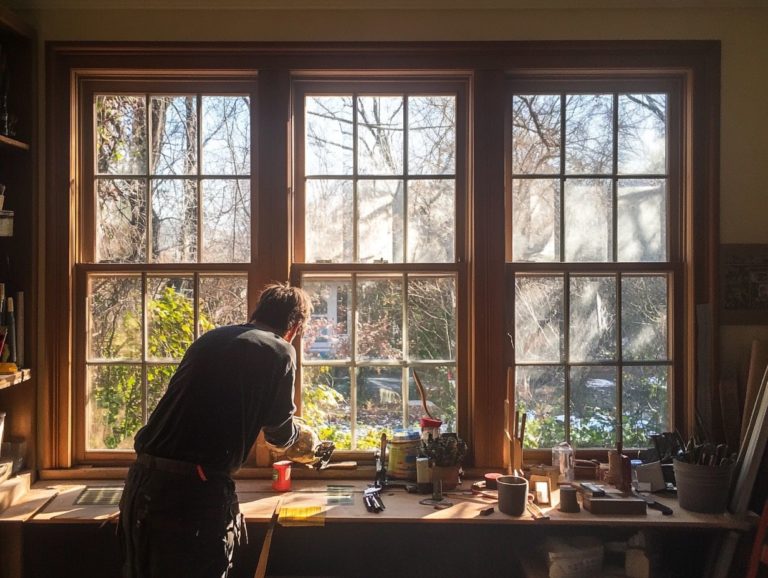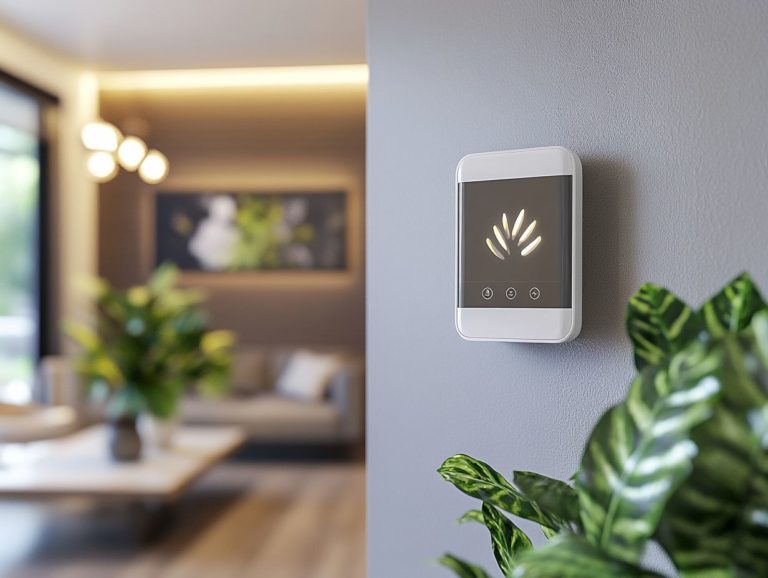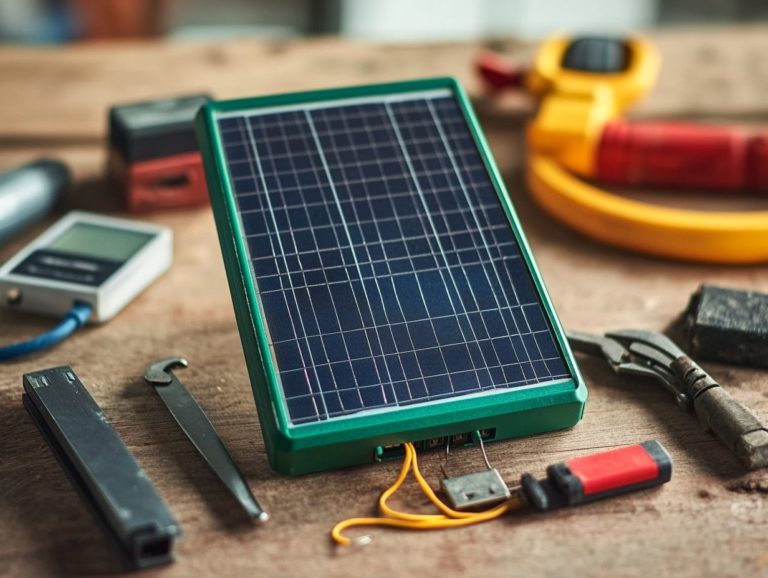How to Build Your Own Solar Water Heater
Are you in search of a sustainable method to heat water while trimming down your energy expenses? A solar water heater may just be the ideal solution for you.
This guide delves into the process of constructing your own solar water heater, highlighting the advantages of DIY systems and weighing the merits of both active and passive designs.
You will also find important maintenance tips to ensure your system operates efficiently over time.
Prepare to harness the power of the sun and transform your water heating experience!
Contents
- Key Takeaways:
- Benefits of Building Your Own
- Types of Solar Water Heaters
- Materials and Tools Needed
- Step-by-Step Guide to Building a Solar Water Heater
- Maintenance and Troubleshooting
- Frequently Asked Questions
- 1. What materials do I need to build my own solar water heater?
- 2. How much does it cost to build a solar water heater?
- 3. Is it difficult to build a solar water heater?
- 4. Do I need to hire a professional to install my solar water heater?
- 5. How much energy can a solar water heater save?
- 6. Can I use a solar water heater in all climates?
Key Takeaways:
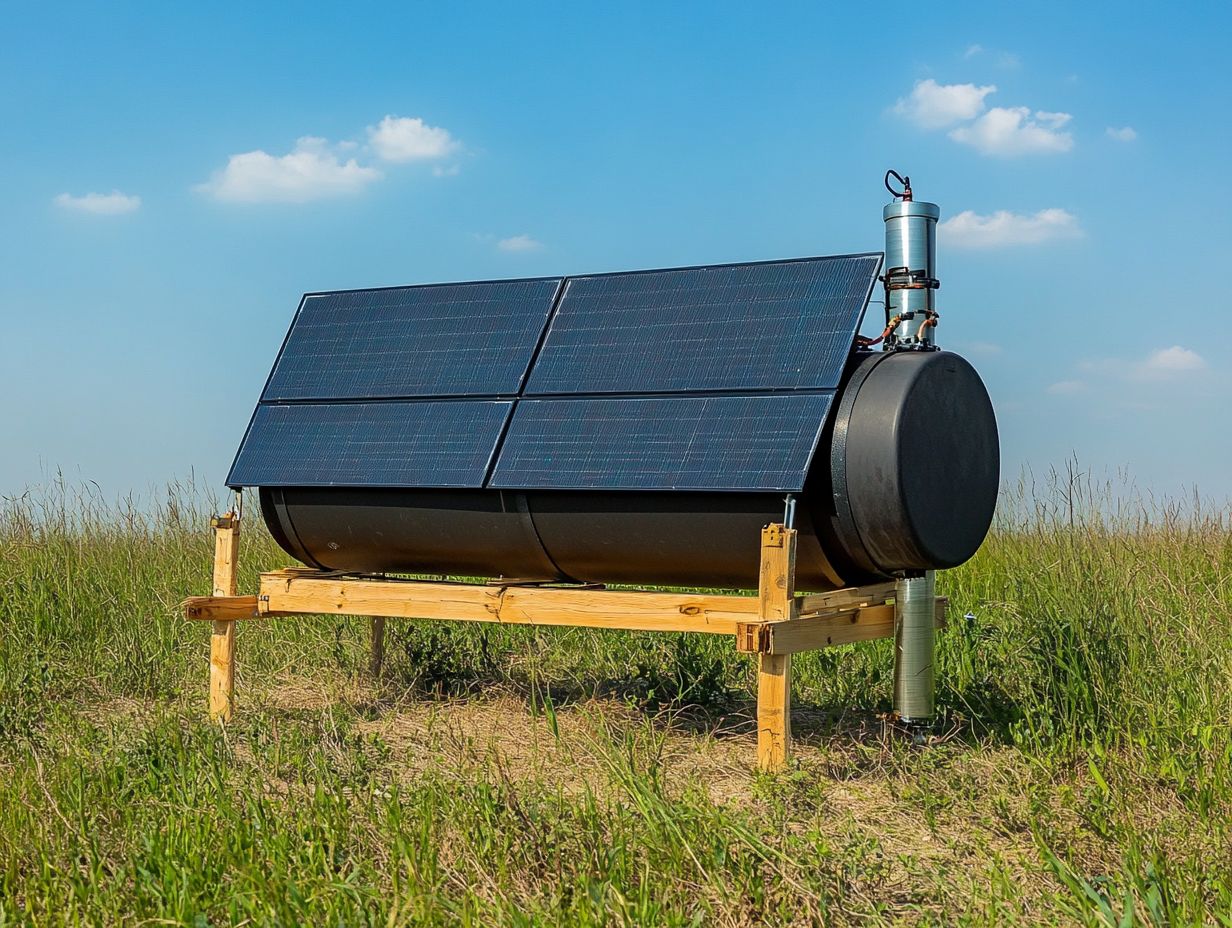
- Save money and reduce environmental impact by building your own solar water heater.
- Understand the difference between active and passive systems to choose the best option for your needs, whether it s for residential or commercial applications.
- Proper maintenance and troubleshooting will ensure your solar water heater runs efficiently for years to come with minimal environmental impact.
What is a Solar Water Heater and What are its Types?
A solar water heater is a system that saves energy, designed to harness solar energy for heating water across various applications, including your residential hot water needs, swimming pools, commercial use, and solar showers. By employing solar collectors that absorb sunlight, these systems convert solar energy into heat, which is then transferred to water stored in well-insulated tanks. You ll find an array of designs available, such as batch heaters, systems that use natural flow, and active systems, each providing you with options for efficient hot water circulation and temperature regulation.
Batch heaters boast a straightforward construction, relying on gravity to store heated water. They are cost-effective, though they may struggle a bit on those overcast days. For improved solar exposure, applying black paint to the collector can enhance heat absorption. If you’re interested in harnessing solar energy more effectively, check out these guidelines for building your own solar panel.
On the flip side, systems that use natural flow take advantage of natural convection to circulate water, guaranteeing a reliable supply of hot water without the need for pumps, which is a nice perk for energy conservation.
If you’re looking for enhanced performance, especially in larger commercial settings, active systems are the way to go, as they incorporate electric or gas-powered pumps. Active systems often include backup heating options to ensure a steady supply of hot water.
Each type offers its own unique benefits, whether it s durability, energy savings, or a minimal environmental impact, catering to your specific hot water needs while promoting sustainable practices.
Benefits of Building Your Own
Building your own solar water heater is a fantastic way to save money and help the planet! This presents an impressive opportunity for significant cost savings and environmental advantages, making it a valuable investment for those keen on renewable energy solutions. Using DIY solar techniques can help in creating low-cost solutions tailored to your needs.
By harnessing DIY solar techniques and materials, you can create budget-friendly alternatives that not only lessen your dependence on traditional heaters but also play a vital role in energy conservation and mitigating global warming.
Furthermore, self-built systems allow you to customize them to meet your specific hot water requirements, ensuring optimal efficiency and superior heat retention.
Start building your solar water heater today and learn how to make your own solar oven to experience the benefits of renewable energy!
Cost Savings and Environmental Impact
The cost savings you can achieve with a solar water heater are nothing short of remarkable, especially when you compare them to the ongoing expenses of an electric water heater or a conventional heater that relies on non-renewable energy sources. By leveraging the capabilities of the sun, you can significantly slash your energy bills and reduce your dependence on fossil fuels.
All this happens while making a positive impact on the environment and supporting sustainable practices. Many families discover that after the initial investment, the reduction in monthly energy costs can more than compensate for the installation price within just a few years.
This switch can lead to amazing savings and a brighter future! It champions energy conservation, as solar water heaters diminish the demand for electricity generated from traditional, polluting methods.
By curbing your overall energy consumption, you play a crucial role in lowering greenhouse gas emissions that contribute to climate change. Ultimately, opting for solar water heating is not just a savvy financial move; it aligns perfectly with the increasing necessity of embracing renewable energy solutions for a healthier planet.
Using a backup heater ensures you have hot water, even during low solar exposure.
Types of Solar Water Heaters
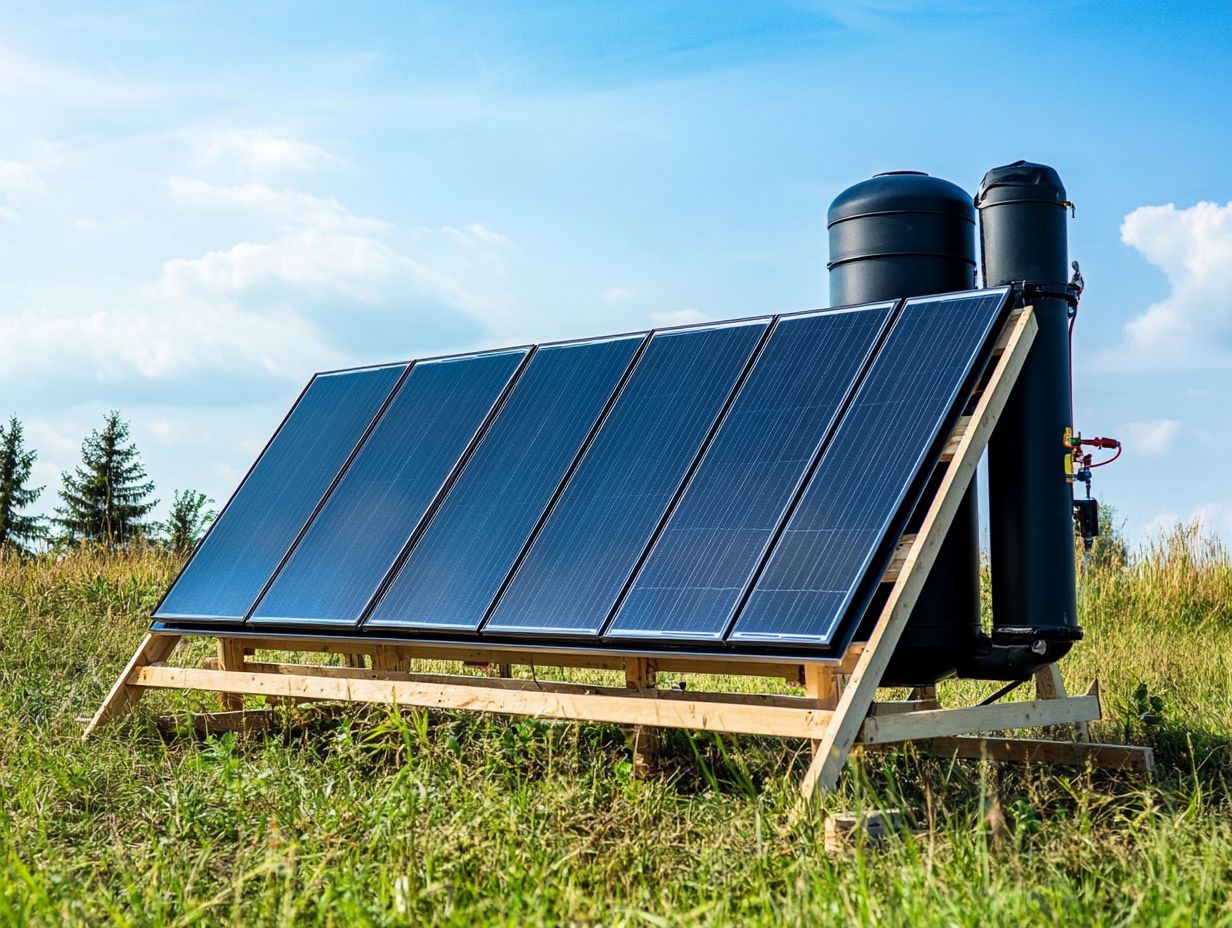
You ll discover a variety of solar water heaters, each meticulously designed to harness solar energy for efficient heating.
Consider batch heaters; they offer a straightforward and budget-friendly solution by utilizing an insulated tank that directly absorbs sunlight to heat water.
Then there are thermosiphon systems, which ingeniously rely on natural circulation to move heated water without pumps, seamlessly transferring warmth from the solar collectors to the storage tank.
Lastly, passive solar systems stand out for their minimalistic approach, operating primarily through natural convection and requiring little to no mechanical components.
Each type presents unique advantages, allowing you to choose the perfect fit for your needs, whether it’s a single-tank heater, a vertical tank design, or a building-integrated heater. Discover which solar heater fits your needs today and make the switch to save money and the planet!
Active vs. Passive Systems
Active and passive solar water heating systems present two distinct pathways for harnessing solar energy, each bringing its own set of advantages and details about how they work. Active systems typically employ pumps and controls to circulate water through solar collectors, ensuring maximum heating capacity and efficiency.
In contrast, passive systems utilize natural processes to circulate water, which means they require less maintenance and no additional mechanical components.
Your choice between these two systems will largely hinge on the specific needs and conditions of your installation site. Active systems tend to shine in environments with higher heating demands, as they can adapt to varying climates and water usage patterns.
Conversely, passive systems may offer a simpler, more cost-effective solution in situations that don’t require as much complexity. Both approaches harness solar energy, but their efficiency can fluctuate based on factors like the quality of the solar collector and the overall system design, ultimately shaping their suitability for residential or commercial applications.
Materials and Tools Needed
To successfully create a solar water heater, you’ll need an array of materials and tools at your disposal. Insulated plywood is essential for constructing a sturdy frame, while PVC tubing facilitates effective water circulation.
Don t overlook the importance of various plumbing tools either. Additionally, the use of glazing materials can help protect the solar collector and improve its efficiency.
Plus, having the right materials, your construction skills will be crucial in ensuring that everything is assembled correctly and operates smoothly. The thoughtful selection and application of these components will significantly influence the performance and longevity of your solar water heating system.
List of Necessary Supplies
Gather the right tools, and you’re well on your way to success! A comprehensive list of necessary supplies for constructing your solar water heater starts with solar collectors to capture precious sunlight and insulated tanks to retain heat. Don’t forget specific plumbing tools for seamless water circulation and connections.
You’ll also want essential accessories to enhance your setup. For example, adding reflectors to the solar collector can maximize sunlight absorption. A heat-transfer fluid, a special liquid that helps move heat from the solar collector to the water, is crucial for efficiently transferring the absorbed energy. The insulated tank is critical for minimizing heat loss, so opting for one with thick insulation can significantly boost energy retention. For those interested in expanding their knowledge, check out our guide on creating homemade solar heating panels and consider using reflective insulation materials to reduce nighttime heat loss.
A suitable thermostat will help you regulate the water temperature, ensuring comfort and safety during use. Additionally, don t overlook standard plumbing tools like wrenches, pipe cutters, and seals; these are essential for secure installations and necessary adjustments throughout the process.
Step-by-Step Guide to Building a Solar Water Heater

Building a solar water heater can be a rewarding DIY endeavor. By following a detailed step-by-step guide, you can ensure a smooth and efficient assembly process.
Start by choosing the ideal location for your solar collector to capture the maximum amount of sunlight. Next, construct an insulated box to house the system’s components, ensuring that it is both functional and well-crafted. For those interested in expanding their DIY skills, consider learning how to make a homemade heat pump as part of your energy projects.
Employing the right installation techniques and paying meticulous attention to detail are vital for achieving optimal performance in your solar water heating system. For those interested in expanding their solar projects, you might explore how to build a solar-powered water pump. Using an insulated box for the collector can enhance heat retention and overall system efficiency.
Instructions and Tips for Assembly
Assemble your solar water heater with clear instructions and basic construction skills to ensure that the system operates effectively, satisfying your hot water needs. Pay close attention to securing all components, adjusting the temperature settings accurately, and positioning the solar collector to absorb maximum sunlight.
To get started, it’s crucial to gather all necessary tools and components before diving into the assembly. This preparation will streamline the process and minimize potential delays. Familiarizing yourself with the assembly manual will provide valuable insights into each step, so take the time to understand it especially the wiring and plumbing connections to avoid leaks or electrical issues.
Once installed, double-checking the temperature settings is essential to ensure that your water heater operates at peak efficiency. If you encounter common problems, such as inadequate heating or water leaks, having troubleshooting tips readily available can save you time and resources, allowing you to make prompt adjustments and keep everything running smoothly.
Maintenance and Troubleshooting
Don’t wait until problems arise check your system regularly to keep it running smoothly! Maintaining and troubleshooting your solar water heater is crucial for ensuring its long-term efficiency and performance. Regular inspections and adjustments are necessary to prevent issues such as heat loss and system inefficiencies.
By consistently checking the solar collector, insulated tank, and water circulation system, you can identify potential problems before they escalate, thereby preserving the integrity of your investment.
By taking these steps, you’ll ensure your solar heater is always ready to deliver hot water when you need it!
How to Keep Your Solar Water Heater Running Efficiently
To keep your solar water heater running efficiently, maintain it regularly. Key tasks include cleaning the solar collector and checking for water circulation issues.
Adjust the temperature controls to match seasonal changes for better efficiency and lower energy consumption. Incorporating regular check-ups into your routine is vital for spotting potential leaks or wear, as these issues can significantly hinder performance.
Make sure to monitor your backup heater closely, ensuring it’s ready to step in seamlessly when needed. Additionally, if you’re interested in enhancing your energy efficiency, consider learning how to build your own energy-efficient greenhouse. Establishing a schedule for these maintenance tasks not only extends the lifespan of your solar water heater but also guarantees a consistent supply of hot water, come rain or shine.
Frequently Asked Questions

1. What materials do I need to build my own solar water heater?
To build your own solar water heater, you will need a solar panel, a water tank, a pump, pipes, and insulation materials. You may also need tools such as a drill, saw, and screwdriver.
2. How much does it cost to build a solar water heater?
The cost of building a solar water heater will depend on the size and type of materials you use. On average, it can cost anywhere from $500 to $2000. However, this is a one-time investment that will save you money on your energy bills in the long run.
3. Is it difficult to build a solar water heater?
Building a solar water heater may require some basic DIY skills and knowledge, but it is not difficult. There are plenty of online tutorials and guides available to help you through the process. With the right materials and instructions, it can be a fun and rewarding DIY project.
4. Do I need to hire a professional to install my solar water heater?
If you have some experience with DIY projects and feel confident, you can install your own solar water heater. However, if you are unsure or uncomfortable with the installation process, it is best to hire a professional to ensure it is installed correctly and safely.
5. How much energy can a solar water heater save?
A properly built and installed solar water heater can save you up to 80% on your water heating costs. This can lead to big savings. Enjoy lower energy bills every month.
6. Can I use a solar water heater in all climates?
Solar water heaters are most effective in areas with plenty of sunlight and warm temperatures. However, they can still be used in colder climates with proper insulation and backup heating systems. It is best to research the climate and weather conditions in your area before deciding to build a solar water heater.

